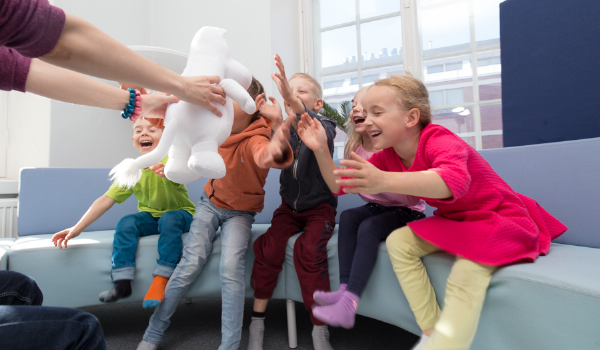Moomin Language School is a language learning service for children learning English or Finnish. The service includes an application that is used for 5-15 minutes per day. Every week has its own theme and vocabulary. For each weekday, there is new learning content with which children can practice all areas of language competence, such as listening and pronunciation. The service is already in use in a number of Finnish kindergartens.
In the Spring of 2017 four kindergartens in Helsinki had a pilot with the Finnish version of Moomin Language School. A pilot study was done in cooperation with the City of Helsinki. The aim was to find out how well Finnish immigrant children, or children with Finnish as a second language, can learn with the Moomin Language School application. The study was led by kindergarten teacher and Doctor of Phonetics Minna Toivola.
Implementation of the Study
The kindergartens had a chance to use the MLS application for eight weeks, from the end of March until the end of May. Each child advanced in the application at their own pace. Because the children’s level of Finnish varied, some children proceeded faster, which meant that they got as far as week 14 in the application. All children completed at least three weeks. The overall time that one child used with the application during the study varied between one hour and four and a half hours. The children’s process was affected by absence and public holidays.
The children’s language skills were measured twice, once in the beginning and once at the end of the pilot study. 46 words were chosen for the initial testing, all of which are presented in the MLS application’s first 15 weeks. In the test situation, children were showed different pictures. The task was to choose the picture that corresponded with the word that the test leader had said. In the second task, the test leader pointed at a picture and children had to say out loud what the picture represented. The second test was done in the same way and all words were based on how far the child had progressed in the learning application.
34 children in total took part in the pilot study. The children’s Finnish knowledge at the beginning depended on when they had come to the kindergarten; some had been in a Finnish-speaking kindergarten for over two years while others came there in the middle of the pilot study. Children who started kindergarten in the middle of the study participated only in the second test.
Results
All children that took part in the pilot study showed positive development in their Finnish language skills. In the second test, only a few children had wrong answers. At best, children who had half of the answers wrong in the first test, had them all right in the second test.
Children, who had not taken part in the first test, had a second test only for pronunciation. On average, these children had been using the application less than the other children. Besides, the test was much more difficult because producing speech is harder than pointing at the right pictures. Also, speech production often develops much later than the understanding of a language. This is known as a silent period, which can last for months, especially when it comes to young learners. However, even though the test was challenging, the results were encouraging. The majority of children gave a correct answer to over 60% of the questions. Even children who had weaker skills in speaking had developed a strong understanding of the language.
In addition to these results, the study also gives us insight into children’s motivation towards using the tablet for learning, and not only for entertainment. Generally, children were interested in using the application and language learning. Especially children who were only beginning to learn Finnish were highly motivated to use the application. The different exercise types catered well to the children’s varying interests; for example, recording one’s speech and listening to it in the language studio was especially enjoyable to some, and a safe way for the shy kids to try speaking Finnish.
Because of the short duration, these results are naturally only preliminary. However, they clearly show that the methods of Moomin Language School are effective. It is important for us to study our solution’s effectiveness and performance, so that we can develop and offer children the best possible way for learning languages.
Toivola, M. (2017). Tutkimusraportti suomi toisena kielenä oppimisesta Moomin Language School -oppimissovelluksen avulla neljässä Helsingin Kaupungin päiväkodissa. Promentor Solutions, Helsinki.


